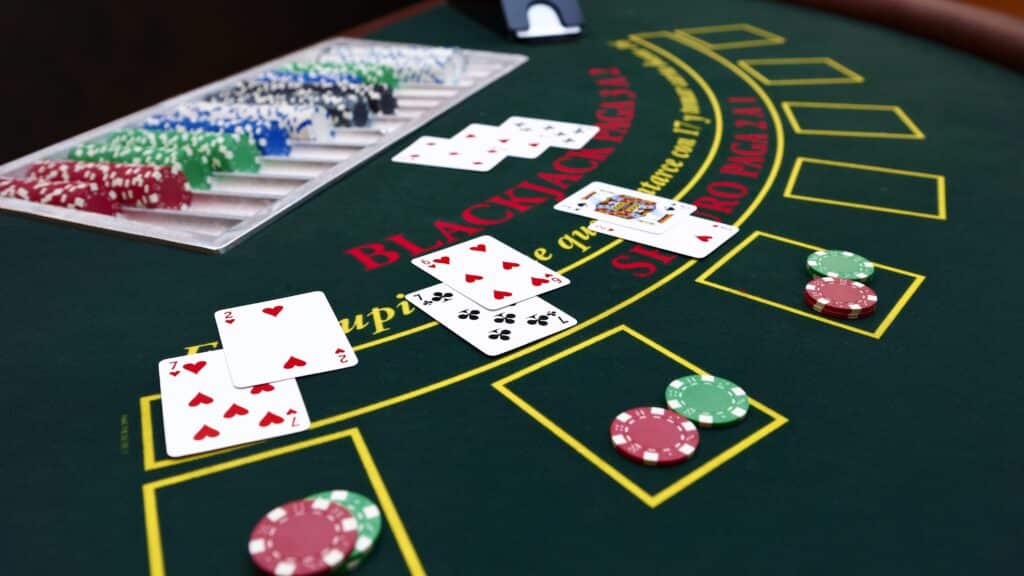Classic Blackjack remains a cornerstone of casino gaming, revered for its blend of chance and skill, and understanding the nuances of this iconic card game is crucial for any aspiring professional gambler.
Understanding the Fundamentals of Classic Blackjack
Classic Blackjack, often simply referred to as Blackjack, is a globally popular casino game played with one or more decks of 52 cards. The primary objective in Blackjack is straightforward: beat the dealer. This can be achieved in several ways: by getting a Blackjack (a total of 21 on your first two cards) without the dealer also getting a Blackjack, by reaching a final score higher than the dealer without exceeding 21, or by the dealer busting (going over 21) while your hand is 21 or less. It’s important to note that in Classic Blackjack, you are not competing against other players at the table; your game is solely against the dealer.
Card values in Blackjack are easily grasped. Numbered cards (2 through 10) are worth their face value. Face cards (Jack, Queen, King) are each valued at 10. An Ace is unique, holding a value of 1 or 11, whichever benefits the hand more without exceeding 21. For instance, an Ace and a 5 could be counted as 6 or 16. This flexibility of the Ace is a strategic element in Blackjack.
Gameplay commences with players placing their bets before cards are dealt. Typically, each player and the dealer receive two cards. Players’ cards are usually dealt face up, while the dealer typically has one card face up and one face down (the ‘hole card’). The game proceeds with each player, in turn, deciding how to play their hand. The basic options are to ‘Hit’ (take another card), ‘Stand’ (end your turn with your current hand), ‘Double Down’ (double your bet and take one more card), ‘Split’ (if you have a pair, split them into two separate hands), and ‘Surrender’ (in some variations, forfeit half your bet and end the hand immediately). These decisions are based on the player’s hand and the dealer’s visible card, aiming to get as close to 21 as possible without busting, or to have the dealer bust.
Mastering Basic Blackjack Strategy
Basic strategy in Blackjack is not about hunches or gut feelings; it’s a mathematically derived approach that tells you the optimal action for every possible hand you could be dealt, based on the dealer’s up card. This strategy is formulated from computer simulations that have played millions of Blackjack hands to determine the most favorable action in each scenario, minimizing the house edge to approximately 1% or even less in some game variations.
A basic strategy chart is an indispensable tool for any serious Blackjack player. These charts are readily available online and in gambling literature. They provide clear guidelines on whether to Hit, Stand, Double Down, or Split, depending on your hand total and the dealer’s up card. For example, a common rule in basic strategy is to always hit on a hard 12 against a dealer’s up card of 2 or 3, but to stand if the dealer shows a 4, 5, or 6. Similarly, it’s generally advised to always split Aces and eights, regardless of the dealer’s up card, as these offer high potential for creating strong hands.
Learning and adhering to basic strategy is the first critical step towards professional Blackjack play. It significantly reduces the house advantage, placing you in a much more competitive position against the casino. While basic strategy doesn’t guarantee wins in every session, it optimizes your decisions over the long run, increasing your chances of profitability and minimizing potential losses. It’s the bedrock upon which more advanced Blackjack techniques are built.
Advanced Techniques for Pro Blackjack Players
Once basic strategy becomes second nature, professional Blackjack players often explore advanced techniques to further refine their edge. Card counting is perhaps the most well-known of these strategies. It involves tracking the ratio of high cards (10s, face cards, Aces) to low cards (2-6) remaining in the deck. When there’s a higher proportion of high cards, the odds shift slightly in the player’s favor. This is because high cards improve the player’s chances of getting a Blackjack and also increase the likelihood of the dealer busting. Card counters adjust their betting strategy and playing decisions based on this ‘count’.
Various card counting systems exist, ranging from simple ‘Hi-Lo’ systems to more complex multi-level counts. The ‘Hi-Lo’ system, for example, assigns a value of +1 to low cards (2-6), -1 to high cards (10, Jack, Queen, King, Ace), and 0 to medium cards (7-9). As cards are dealt, the counter keeps a running total. A positive count indicates more high cards remaining, signaling a potentially advantageous situation for the player. Card counting, while effective, requires significant practice, concentration, and discretion, as casinos actively discourage and may prohibit it.
Another advanced technique is shuffle tracking, which is considerably more complex and less commonly used. It involves attempting to predict how card groups are shuffled and where they might reappear in subsequent deals. While theoretically possible, shuffle tracking is extremely challenging in modern casinos due to sophisticated shuffling machines and procedures. It demands exceptional observational skills and memory, and its effectiveness is debatable in most contemporary Blackjack settings.
Beyond card counting and shuffle tracking, professional players also focus on game selection and rule variations. Different casinos offer Blackjack games with varying rule sets, which can significantly impact the house edge. For instance, games where the dealer stands on soft 17 (S17) are more favorable to players than those where the dealer hits on soft 17 (H17). Similarly, rules regarding doubling down after splitting, re-splitting Aces, and surrender options can all influence the game’s odds. Pro players are adept at identifying and choosing games with the most player-friendly rules to maximize their advantage.
Bankroll Management: Playing Like a Pro
Effective bankroll management is as crucial as strategic gameplay for professional Blackjack players. It’s about managing your gambling funds in a disciplined and calculated manner to withstand the inevitable variance of Blackjack and ensure long-term sustainability. A fundamental principle of bankroll management is to only gamble with money you can afford to lose, and to set clear limits for both wins and losses.
Professional players typically adhere to a strict betting unit system. This involves determining a standard bet size that represents a small percentage of their total bankroll, often around 1-2%. For example, with a $10,000 bankroll, a standard bet might be $100 to $200. This approach helps to minimize the impact of losing streaks and allows for weathering the ups and downs inherent in Blackjack. It’s vital to resist the temptation to increase bet sizes significantly after wins or to chase losses by betting more aggressively when behind.
Setting win and loss limits is another critical aspect of bankroll management. A win limit is a predetermined amount of profit after which you will stop playing, while a loss limit is the maximum amount you are prepared to lose in a session. These limits should be set realistically and adhered to strictly. They help in locking in profits and preventing catastrophic losses. For instance, a player might set a win limit of 50% of their initial bankroll for a session and a loss limit of 25%. Reaching either limit triggers the end of the playing session.
Furthermore, professional bankroll management involves choosing appropriate Blackjack game stakes that align with your bankroll size and betting unit. Playing at stakes that are too high relative to your bankroll can lead to rapid depletion in a losing streak, even when employing sound strategy. Conversely, playing at stakes that are too low might not yield meaningful returns even when winning. The key is to find a balance that allows for comfortable play and potential for profit without undue risk of банкротство.
The Psychology of a Blackjack Pro
The psychological aspect of Blackjack is often underestimated, yet it is a significant component of professional play. Maintaining emotional control, discipline, and focus is paramount to making sound decisions at the Blackjack table, especially under pressure. Blackjack, like all forms of gambling, involves streaks of wins and losses, and the ability to manage emotions during these fluctuations is what separates professional players from amateurs.
Tilt, a state of emotional confusion or frustration that leads to suboptimal play, is a common pitfall in Blackjack. Tilt can be triggered by a series of losses, bad beats, or even overconfidence after a win streak. When tilted, players may deviate from basic strategy, make impulsive decisions, increase bets recklessly, or chase losses. Recognizing the onset of tilt and taking steps to regain composure is crucial. This might involve taking a break from the game, stepping away from the table, or employing mental techniques to refocus and regain emotional equilibrium.
Discipline is another cornerstone of the Blackjack mindset. It encompasses adherence to basic strategy, bankroll management rules, and pre-set win and loss limits. Discipline means sticking to the plan even when intuition or emotions suggest otherwise. It’s about making mathematically sound decisions consistently, regardless of short-term outcomes. Professional players understand that Blackjack is a game of long-term probabilities, and discipline is essential to realize those probabilities over time.
Focus and concentration are equally vital. Blackjack requires constant attention to the cards, the dealer’s actions, and the game situation. Distractions, fatigue, and lapses in concentration can lead to errors in strategy execution, missed opportunities, and increased vulnerability to the house edge. Professional players cultivate focus through practice, minimizing distractions, and ensuring they are mentally and physically prepared before engaging in a Blackjack session. This mental fortitude is as important as strategic knowledge and bankroll management in achieving consistent success in Blackjack.
Common Pitfalls to Avoid in Blackjack
Even with a solid understanding of strategy and bankroll management, Blackjack players can fall into common traps that erode their edge. One frequent mistake is deviating from basic strategy based on hunches or feelings. Basic strategy is mathematically proven to be optimal in the long run, and any deviation from it increases the house advantage. Players might be tempted to ‘hit’ on a hard 17 against a dealer’s 7, for example, believing the dealer is likely to have a 10 in the hole. However, basic strategy dictates standing in this situation, and consistently following this advice is statistically more profitable.
Another common error is improper bankroll management. Many players, especially beginners, fail to set or adhere to win and loss limits. They might continue playing after reaching a win goal, hoping for even more profit, or chase losses by increasing bets when on a losing streak. Both of these behaviors can quickly deplete a bankroll. Sticking to predetermined limits and betting units, regardless of short-term outcomes, is essential for long-term success.
Ignoring game rules and variations is another pitfall. Blackjack rules can vary significantly between casinos and even between tables within the same casino. Rules like dealer standing on soft 17 versus hitting, Blackjack payout (3:2 or 6:5), doubling down options, and surrender availability all impact the house edge. Playing without understanding these rules, or choosing games with unfavorable rules, puts the player at a disadvantage. Professional players always familiarize themselves with the specific rules of the game they are playing and select games with the most player-friendly conditions.
Emotional play is a significant detriment to Blackjack success. Letting emotions like frustration, excitement, or boredom dictate decisions is a recipe for disaster. Emotional play often leads to impulsive bets, strategy deviations, and poor bankroll management. Maintaining a calm, rational, and focused mindset is crucial. Recognizing emotional triggers and taking steps to manage them, such as taking breaks or ending a session when feeling overwhelmed, is vital for consistent, professional Blackjack play.
Pro Tips for Elevating Your Blackjack Game
To truly play Blackjack like a professional, integrating several key tips into your game is essential. Firstly, master basic strategy to perfection. This is non-negotiable. Use strategy charts and practice tools until your basic strategy decisions are automatic and flawless. This forms the foundation of all advanced play.
Secondly, understand and utilize card counting techniques if you aim for a serious edge. Start with a simple system like Hi-Lo and practice diligently until you can maintain an accurate count in a distracting casino environment. Remember, card counting is not foolproof and requires discretion and skill to avoid detection.
Thirdly, be selective about game rules. Always opt for games with player-favorable rules, such as dealer stands on soft 17, 3:2 Blackjack payouts, and liberal doubling and splitting rules. These rules significantly reduce the house edge and increase your potential for profit.
Fourthly, implement rigorous bankroll management. Set clear win and loss limits, establish a betting unit system, and stick to them religiously. Treat your bankroll as a business investment and manage it with the same discipline and care.
Fifthly, develop mental fortitude. Cultivate emotional control, discipline, and focus. Practice mindfulness and techniques to manage tilt and maintain composure under pressure. A strong mental game is as important as strategic skill in Blackjack.
Sixthly, practice consistently and analyze your play. Use online Blackjack simulators to practice basic strategy and card counting. Review your playing sessions to identify mistakes and areas for improvement. Continuous learning and refinement are key to professional growth.
Finally, stay informed about Blackjack variations and trends. While Classic Blackjack remains fundamental, understanding different variations and emerging trends can broaden your expertise and adaptability as a player. Explore variations like Spanish 21, Blackjack Switch, or Free Bet Blackjack to diversify your knowledge and potentially find more advantageous games.
Conclusion: The Path to Blackjack Mastery
Embarking on the path to professional Blackjack play is a journey that demands dedication, skill, and a deep understanding of the game. It extends far beyond mere luck, delving into the realms of mathematical strategy, psychological resilience, and disciplined bankroll management. While the allure of quick wins can be tempting, true mastery in Classic Blackjack is built upon a foundation of rigorous study and consistent practice. By internalizing basic strategy, exploring advanced techniques like card counting, and meticulously managing your bankroll, you begin to shift the odds in your favor.
However, it’s equally crucial to cultivate the psychological fortitude needed to withstand the game’s inherent variance and maintain composure under pressure. The professional Blackjack player is not just a gambler; they are a strategist, a psychologist, and a disciplined financial manager, all rolled into one. As you progress on this journey, remember that continuous learning, self-analysis, and adaptation are your greatest allies in the pursuit of Blackjack excellence. The game of Classic Blackjack, while seemingly simple on the surface, offers a rich and complex landscape for those willing to delve deep and play with professional acumen.
External Resources:



